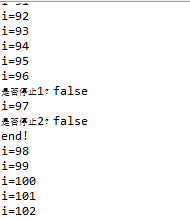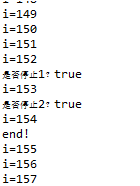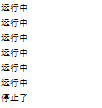文章目录
isAlive方法
主要是用来判断当前线程是否处于活动状态。
package multiply.com.test;
public class MyThread extends Thread {
@Override
public void run() {
System.out.println("run="+this.isAlive());
}
}
package multiply.com.test;
public class Run {
public static void main(String[] args) throws InterruptedException {
MyThread myThread = new MyThread();
System.out.println("begin="+myThread.isAlive());
myThread.start();
Thread.sleep(1000);
System.out.println("end="+myThread.isAlive());
}
}
begin=false
run=true
end=false
先是main线程启动,然后myThread线程启动,main线程休眠,main线程再启动。
sleep()方法
package multiply.com.test;
public class MyThread extends Thread{
@Override
public void run() {
try {
System.out.println("run begin:"+this.currentThread().getName());
Thread.sleep(2000);
System.out.println("run end:"+this.currentThread().getName());
} catch (InterruptedException e) {
e.printStackTrace();
}
}
}
package multiply.com.test;
public class Run {
public static void main(String[] args) throws InterruptedException {
MyThread myThread = new MyThread();
System.out.println("begin");
//这里是main线程中调用myThread线程中的run方法,所以当前线程还是main线程
//myThread.run();
//main线程与myThread线程是异步执行的,先执行main线程,然后执行myThread线程
myThread.start();
System.out.println("end");
}
}
begin
end
run begin:Thread-0
run end:Thread-0
采用myThread.run():
begin
run begin:main
run end:main
end
getId()方法
作用就是获得线程的唯一标识。
停止线程
停止不了的线程
interrupt()方法仅仅在当前线程中打了一个暂停的标记,并不是真的停止线程。
判断线程是否是停止状态
package multiply.com.test;
public class MyThread extends Thread {
@Override
public void run() {
super.run();
for (int i = 0; i < 200; i++) {
System.out.println("i=" + (i + 1));
}
}
}
package multiply.com.test;
public class Run {
public static void main(String[] args) {
try {
MyThread thread = new MyThread();
thread.start();
//主线程休眠1ms
Thread.sleep(1);
//休眠结束,两个线程同时运行,thread打上false标记,中断了,但程序并没有停止。
thread.interrupt();
//判断当前线程(main线程)没有中断。
System.out.println("是否停止1?" + thread.interrupted());
System.out.println("是否停止2?" + thread.interrupted());
} catch (InterruptedException e) {
System.out.println("main catch");
e.printStackTrace();
}
System.out.println("end!");
}
}
当前线程main线程没有中断。
package multiply.com.test;
public class Run {
public static void main(String[] args) {
//主线程打标记,中断,但是并没有真正中断,程序还是继续运行
Thread.currentThread().interrupt();
System.out.println("是否停止1?" + Thread.interrupted());
System.out.println("是否停止2?" + Thread.interrupted());
}
}
是否停止1?true
是否停止2?false
package multiply.com.test;
public class Run {
public static void main(String[] args) {
try {
MyThread thread = new MyThread();
thread.start();
Thread.sleep(1);
thread.interrupt();
//判断是thread对象是否中断,但并不清理标记
System.out.println("是否停止1?" + thread.isInterrupted());
System.out.println("是否停止2?" + thread.isInterrupted());
} catch (InterruptedException e) {
System.out.println("main catch");
e.printStackTrace();
}
System.out.println("end!");
}
}
能停止的线程–异常法
package multiply.com.test;
public class MyThread extends Thread {
@Override
public void run() {
super.run();
for (int i = 0; i < 200; i++) {
if(this.interrupted())
{
System.out.println("已经是停止状态!我要退出了!" );
break;
}
System.out.println("i=" + (i + 1));
}
System.out.println("程序还在运行!");
}
}
package multiply.com.test;
public class Run {
public static void main(String[] args) {
try {
MyThread thread = new MyThread();
thread.start();
Thread.sleep(1);
thread.interrupt();
} catch (InterruptedException e) {
System.out.println("main catch");
e.printStackTrace();
}
System.out.println("end!");
}
}
如何解决程序还在继续运行呢?
package multiply.com.test;
public class MyThread extends Thread {
@Override
public void run() {
super.run();
try
{
for (int i = 0; i < 200; i++) {
if(this.interrupted())
{
System.out.println("已经是停止状态!我要退出了!" );
throw new InterruptedException();
}
System.out.println("i=" + (i + 1));
}
System.out.println("程序还在运行!");
}catch(InterruptedException e) {
System.out.println("进入到catch了!");
e.printStackTrace();
}
}
}
在沉睡中停止
package multiply.com.test;
public class MyThread extends Thread {
@Override
public void run() {
super.run();
try
{
System.out.println("run begin");
Thread.sleep(200000);
System.out.println("run end");
}catch(InterruptedException e) {
System.out.println("进入到catch了!"+this.isInterrupted());
e.printStackTrace();
}
}
}
package multiply.com.test;
public class Run {
public static void main(String[] args) {
try {
MyThread thread = new MyThread();
thread.start();
Thread.sleep(200);
thread.interrupt();
} catch (InterruptedException e) {
System.out.println("main catch");
e.printStackTrace();
}
System.out.println("end!");
}
}
所以this.isInterrupted()在这里显示的就是false。
能停止的线程–暴力停止
package multiply.com.test;
public class SynchronizedObject {
private String username = "a";
private String password = "aa";
public String getUsername() {
return username;
}
public void setUsername(String username) {
this.username = username;
}
public String getPassword() {
return password;
}
public void setPassword(String password) {
this.password = password;
}
synchronized public void printString(String username, String password) {
try {
this.username = username;
Thread.sleep(100000);
this.password = password;
} catch (InterruptedException e) {
e.printStackTrace();
}
}
}
package multiply.com.test;
public class MyThread extends Thread {
private SynchronizedObject object;
public MyThread(SynchronizedObject object) {
super();
this.object = object;
}
@Override
public void run() {
object.printString(" b", "bb");
}
}
package multiply.com.test;
public class Run {
public static void main(String[] args) {
try {
SynchronizedObject object = new SynchronizedObject();
MyThread thread = new MyThread(object);
thread.start();
Thread.sleep(500);
thread.stop();
System.out.println(object.getUsername() + " " + object.getPassword());
} catch (InterruptedException e) {
e.printStackTrace();
}
}
}
b aa
使用return停止线程
package multiply.com.test;
public class MyThread extends Thread {
@Override
public void run() {
while(true)
{
if(this.interrupted())
{
System.out.println("停止了");
return;
}
System.out.println("运行中");
}
}
}
package multiply.com.test;
public class Run {
public static void main(String[] args) throws InterruptedException {
MyThread thread = new MyThread();
thread.start();
Thread.sleep(500);
thread.interrupt();
}
}
暂停线程
独占
package multiply.com.test;
public class SynchronizedObject {
synchronized public void printString() {
System.out.println("begin");
if (Thread.currentThread().getName().equals("a")) {
System.out.println("a线程永远suspend了!");
Thread.currentThread().suspend();
}
System.out.println("end");
}
}
package multiply.com.test;
public class Run {
public static void main(String[] args) {
try {
final SynchronizedObject object = new SynchronizedObject();
Thread thread1 = new Thread() {
@Override
public void run() {
object.printString();
}
};
thread1.setName("a");
thread1.start();
Thread.sleep(1000);
Thread thread2 = new Thread() {
@Override
public void run() {
System.out.println("thread2启动了,但进不了printString()方法!只打印了一个begin");
System.out.println("因为printString()方法被a线程锁定,并且永远suspend暂停了");
object.printString();
}
};
thread2.start();
} catch (InterruptedException e) {
e.printStackTrace();
}
}
}
begin
a线程永远suspend了!
thread2启动了,但进不了printString()方法!只打印了一个begin
因为printString()方法被a线程锁定,并且永远suspend暂停了
package multiply.com.test;
public class MyThread extends Thread {
private long i = 0;
@Override
public void run() {
while(true)
{
i++;
System.out.println(i);
}
}
}
package multiply.com.test;
public class Run {
public static void main(String[] args) {
try {
MyThread thread1 = new MyThread();
thread1.start();
Thread.sleep(1000);
thread1.suspend();
System.out.println("main end");
} catch (InterruptedException e) {
e.printStackTrace();
}
}
}
没有打印出main end
不同步
package multiply.com.test;
public class MyObject {
private String username = "1";
private String password = "11";
public void setValue(String u, String p) {
this.username = u;
if (Thread.currentThread().getName().equals("a")) {
System.out.println("停止a线程");
Thread.currentThread().suspend();
}
this.password = p;
}
public void printUsernamePassword() {
System.out.println(username + " " + password);
}
}
package multiply.com.test;
public class Run {
public static void main(String[] args) throws InterruptedException {
final MyObject myObject = new MyObject();
Thread thread1 = new Thread() {
@Override
public void run() {
myObject.setValue("a", "aa");
}
};
thread1.setName("a");
thread1.start();
Thread.sleep(500);
Thread thread2 = new Thread() {
@Override
public void run() {
myObject.printUsernamePassword();
}
};
thread2.start();
}
}
停止a线程
a 11
yeild方法
线程优先级
优先级具有规则性:
package multiply.com.test;
import java.util.Random;
public class MyThread1 extends Thread {
@Override
public void run() {
long beginTime = System.currentTimeMillis();
long addResult = 0;
for (int j = 0; j < 10; j++) {
for (int i = 0; i < 50000; i++) {
Random random = new Random();
random.nextInt();
addResult = addResult + i;
}
}
long endTime = System.currentTimeMillis();
System.out.println("*****thread 1 use time=" + (endTime - beginTime));
}
}
package multiply.com.test;
import java.util.Random;
public class MyThread2 extends Thread {
@Override
public void run() {
long beginTime = System.currentTimeMillis();
long addResult = 0;
for (int j = 0; j < 10; j++) {
for (int i = 0; i < 50000; i++) {
Random random = new Random();
random.nextInt();
addResult = addResult + i;
}
}
long endTime = System.currentTimeMillis();
System.out.println("*****thread 2 use time=" + (endTime - beginTime));
}
}
package multiply.com.test;
public class Run {
public static void main(String[] args) {
for (int i = 0; i < 5; i++) {
MyThread1 thread1 = new MyThread1();
thread1.setPriority(10);
thread1.start();
MyThread2 thread2 = new MyThread2();
thread2.setPriority(1);
thread2.start();
}
}
}
*****thread 1 use time=421
*****thread 1 use time=484
*****thread 2 use time=508
*****thread 1 use time=510
*****thread 1 use time=514
*****thread 2 use time=522
*****thread 2 use time=522
*****thread 2 use time=524
*****thread 2 use time=525
*****thread 1 use time=527
优先级具有随机性:
























